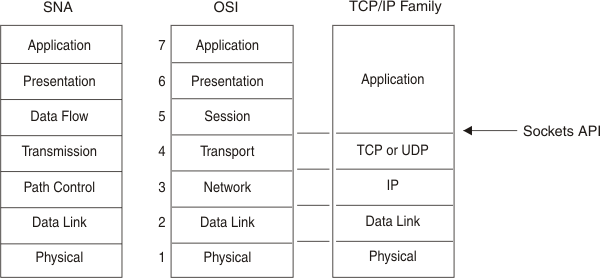TCP/IP TCP, UDP, and IP protocols
TCP/IP is a large family of protocols that is named after its two most important members. Figure 1 shows the TCP/IP protocols used by CICS® TCP/IP, in terms of the layered Open Systems Interconnection (OSI) model, which is widely used to describe data communication systems. For CICS users who might be more accustomed to SNA, the left side of Figure 1 shows the SNA layers, which correspond very closely to the OSI layers.

The protocols implemented by TCP/IP Services and used by CICS TCP/IP are
shown in the right hand column in Figure 1:
- Transmission Control Protocol (TCP)
- In terms of the OSI model, TCP is a transport-layer protocol. It provides a reliable virtual-circuit connection between applications; that is, a connection is established before data transmission begins. Data is sent without errors or duplication and is received in the same order as it is sent. No boundaries are imposed on the data; TCP treats the data as a stream of bytes.
- User Datagram Protocol (UDP)
- UDP is also a transport-layer protocol and is an alternative to TCP. It provides an unreliable datagram connection between applications. Data is transmitted link by link; there is no end-to-end connection. The service provides no guarantees. Data can be lost or duplicated, and datagrams can arrive out of order.
- Internet Protocol (IP)
- In terms of the OSI model, IP is a network-layer protocol. It provides a datagram service between applications, supporting both TCP and UDP.